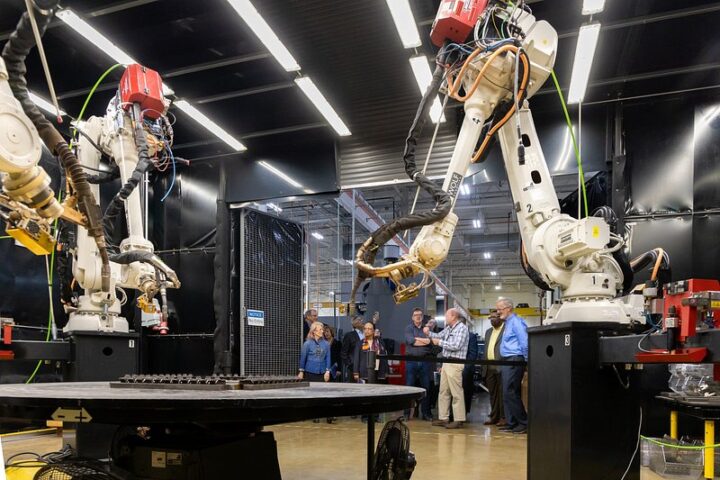
Mastering Fuel Efficiency: Practical Driving Tips for Every Driver
February 26, 2024
Top 10 Strategies for Effective Weight Loss and Healthy Living
March 1, 2024The Revolutionary Impact of Artificial Intelligence on the Automotive Industry
Introduction
Artificial Intelligence (AI) has emerged as a transformative force in the automotive industry, reshaping vehicle manufacturing, safety standards, autonomous driving, and customer experience. This comprehensive exploration delves into the multifaceted ways AI is revolutionizing the automotive landscape, propelling it toward a safer, smarter, and more efficient future. From predictive maintenance to autonomous vehicles, AI is driving unprecedented innovation and transformation across the automotive sector.
AI Revolutionizing Vehicle Manufacturing
AI is at the forefront of revolutionizing vehicle manufacturing processes, enhancing efficiency, quality, and safety across the production line. Key areas where AI is making a substantial impact include:
Predictive Maintenance: AI-powered predictive maintenance systems analyze real-time data to predict machinery failures in advance, enabling proactive maintenance and minimizing downtime.
Quality Control: AI-driven computer vision systems swiftly identify defects in components or finished vehicles, ensuring only top-quality products reach the market.
Supply Chain Optimization: AI algorithms optimize supply chains by predicting demand, managing inventory, optimizing logistics, streamlining operations, and reducing costs.
Robot-Assisted Manufacturing: Robots equipped with AI perform intricate tasks with precision and speed, improving both quality and efficiency in assembly processes.
Design and Prototyping: AI algorithms aid in vehicle design and prototyping, creating innovative designs while considering factors like aerodynamics, safety, and aesthetics.
Energy Efficiency: AI optimizes energy consumption in manufacturing facilities by adjusting lighting, HVAC systems, and machinery operation in real time.
Worker Safety: AI-enhanced safety measures protect workers on the production floor by detecting potential hazards and preventing accidents.
Customization: AI enables greater customization in vehicle manufacturing, allowing manufacturers to offer personalized features efficiently.
In summary, AI is revolutionizing vehicle manufacturing by optimizing processes, improving quality, and enabling greater customization, leading to more efficient and innovative manufacturing practices.
AI Driving Autonomous Vehicles
Autonomous driving, once a futuristic concept, is rapidly becoming a reality with the integration of AI in the automotive industry. AI is critical in making self-driving vehicles safer, more reliable, and practical for everyday use. Key aspects of AI’s impact on autonomous driving include:
Sensor Fusion: AI algorithms combine data from various sensors to create a comprehensive view of the vehicle’s surroundings, enabling accurate perception and informed decision-making.
Machine Learning for Perception: Machine learning models continuously improve recognition capabilities through real-world data, making autonomous vehicles more adept at handling complex scenarios.
Control and Path Planning: AI-driven control systems calculate optimal paths and make real-time decisions on acceleration, braking, and steering, ensuring smooth and safe driving.
Simulations for Testing: AI-powered simulation environments allow manufacturers to test autonomous vehicles in various scenarios, accelerating the development process.
Connectivity and Communication: AI facilitates vehicle-to-vehicle and vehicle-to-infrastructure communication, enhancing safety and efficiency on the road.
ADAS (Advanced Driver Assistance Systems): ADAS features rely on AI to improve driver safety and reduce the risk of accidents, often serving as the foundation for full autonomy.
Robust Decision-Making: AI algorithms prioritize safety in ambiguous situations, ensuring autonomous vehicles prioritize passenger and public safety.
Regulations and Ethics: Ethical considerations and regulatory compliance are crucial in AI-driven autonomous driving to ensure safety and responsible decision-making.
In conclusion, AI is at the heart of autonomous driving, enabling vehicles to perceive their environment, make intelligent decisions, and navigate safely. As technology advances, we can anticipate even greater strides in the development and deployment of autonomous vehicles, promising a future with safer and more efficient transportation.
AI Revolutionizing Vehicle Safety
Artificial Intelligence is fundamentally transforming vehicle safety, making roads safer for both drivers and pedestrians. Through the integration of AI technologies, automotive companies are reducing accidents, improving emergency response, and enhancing overall safety. Key areas where AI is revolutionizing vehicle safety include:
Collision Avoidance Systems: AI-driven collision avoidance systems utilize sensors and real-time data analysis to detect potential collisions and mitigate their impact.
Adaptive Cruise Control (ACC): ACC systems automatically adjust the speed of the vehicle, reducing the likelihood of rear-end collisions caused by sudden stops or slowdowns.
Lane Departure Warning and Assist: AI-equipped vehicles detect lane markings and provide warnings or assistance to prevent unintentional lane departures.
Advanced Driver Monitoring: AI monitors driver behavior and detects signs of drowsiness or distraction, reducing the risk of accidents caused by impaired driving.
Pedestrian and Cyclist Detection: AI algorithms identify pedestrians and cyclists near the vehicle, triggering warnings or emergency braking to prevent collisions.
Traffic Sign Recognition: AI systems recognize and interpret traffic signs, providing alerts to ensure compliance with traffic regulations.
Emergency Braking Systems: AI-driven emergency braking systems detect imminent collisions and apply the brakes faster than human reaction time.
Vehicle-to-Everything (V2X) Communication: V2X communication enables vehicles to exchange information about road conditions, traffic, and hazards, enhancing overall safety.
In conclusion, AI is reshaping vehicle safety by proactively preventing accidents, assisting drivers, and improving emergency response. With continued advancements in AI technology, we can anticipate even safer roadways and a significant reduction in traffic-related injuries and fatalities.
AI in Predictive Maintenance
Artificial Intelligence is reshaping maintenance practices in the automotive industry through predictive maintenance. This technology allows manufacturers and service providers to monitor vehicle health in real time, predict maintenance needs, and optimize schedules. Key aspects of AI in predictive maintenance include:
Condition Monitoring Sensors: AI-driven predictive maintenance begins with sensors that collect data on various components, enabling real-time monitoring.
Machine Learning Algorithms: Machine learning algorithms process data to identify patterns and predict when components are likely to fail.
Predictive Alerts: AI sends predictive alerts to vehicle owners or service centers when maintenance is needed, minimizing downtime and unexpected breakdowns.
Condition-Based Maintenance: AI enables condition-based maintenance, ensuring components are serviced or replaced only when necessary.
Fleet Management: Fleet managers benefit from AI-driven predictive maintenance by optimizing schedules and reducing downtime.
Cost Savings: Predictive maintenance reduces maintenance costs and unplanned breakdowns, resulting in significant savings over time.
Data-Driven Decision-Making: AI empowers companies with data-driven insights to make strategic decisions about vehicle design, manufacturing, and servicing.
Improved Safety: Predictive maintenance contributes to vehicle safety by ensuring critical components are in optimal condition, reducing the risk of accidents.
In conclusion, AI-driven predictive maintenance is revolutionizing the automotive industry by enhancing reliability, reducing costs, and improving safety. As AI technology evolves, we can expect more sophisticated solutions that benefit both vehicle owners and manufacturers.
AI Enhancing Customer Experience
Artificial Intelligence is revolutionizing the customer experience in the automotive industry by delivering personalized, efficient, and satisfying interactions. Key areas where AI is reshaping the customer journey include:
Virtual Assistants and Chatbots: AI-powered virtual assistants engage with customers 24/7, answering questions and assisting with tasks.
Personalized Recommendations: AI algorithms analyze customer data to provide personalized recommendations for purchases and services.
Virtual Showrooms and Test Drives: AI enables virtual experiences, allowing customers to explore vehicle models and features remotely.
Predictive Maintenance Notifications: AI sends notifications to inform vehicle owners when maintenance is due, minimizing inconvenience.
Improved Customer Service: AI provides quick solutions to customer inquiries and service-related concerns.
Voice Assistants in Vehicles: Voice-activated AI assistants enhance in-car experiences by enabling hands-free control of functions.
Streamlined Buying Process: AI streamlines the vehicle buying process by guiding customers through financing options and paperwork.
Data-Driven Feedback: AI collects and analyzes customer feedback to inform product improvements and marketing strategies.
In conclusion, AI-driven solutions are creating a more convenient, efficient, and satisfying customer experience in the automotive industry. As AI continues to evolve, we can expect further innovations that enhance customer engagement and satisfaction.
AI Revolutionizing Traffic Management
Artificial Intelligence is revolutionizing traffic management, making urban transportation more efficient, safe, and sustainable. Key areas where AI is transforming traffic management include:
Traffic Prediction and Management: AI analyzes data to predict congestion and implement proactive measures to alleviate traffic.
Smart Traffic Signals: AI-driven signals prioritize traffic flow in high-traffic areas, reducing waiting times and fuel consumption.
Adaptive Cruise Control: AI-equipped vehicles maintain safe following distances and adjust speeds to optimize traffic flow.
Incident Detection and Response: AI systems detect traffic incidents and enable faster response times to minimize disruptions.
Autonomous Vehicles and V2X Communication: AI enables communication between vehicles and infrastructure, enhancing safety and efficiency.
Parking Optimization: AI helps drivers find available parking spaces efficiently, reducing traffic caused by parking searches.
Traffic Enforcement: AI automates traffic enforcement through license plate recognition systems.
Public Transportation Optimization: AI optimizes public transportation routes and schedules to reduce traffic congestion.
In conclusion, AI-driven solutions are playing a pivotal role in creating more efficient and sustainable transportation systems. As urban areas grow, AI technologies will continue to be instrumental in addressing traffic challenges.
AI Challenges and Concerns
While AI brings transformative benefits to the automotive industry, it also presents challenges and concerns that must be addressed to ensure responsible integration. Key challenges and concerns include:
Safety and Reliability: Ensuring the safety and reliability of AI-driven systems is paramount to prevent accidents and system failures.
Data Privacy: Protecting data privacy and safeguarding against breaches is crucial as AI relies heavily on data.
Ethical Decision-Making: Establishing ethical guidelines for AI decision-making, especially in autonomous vehicles, remains a challenge.
Regulatory Compliance: Compliance with regulations and safety standards is essential for the responsible integration of AI technologies.
Integration with Legacy Systems: Integrating AI into existing vehicles and infrastructure poses challenges related to compatibility and cost.
Cybersecurity Threats: Protecting vehicles from cyberattacks and ensuring secure communication is essential.
Bias and Fairness: Ensuring fairness and equity in AI decision-making processes is critical to prevent biased outcomes.
Consumer Trust and Education: Building consumer trust and understanding of AI technologies is essential for widespread adoption.
In conclusion, addressing these challenges and concerns through collaborative efforts is crucial to realizing the full potential of AI in the automotive sector responsibly.
Conclusion
In conclusion, Artificial Intelligence is transforming the automotive industry in profound ways, reshaping manufacturing, safety, customer experience, and traffic management. While AI brings unprecedented opportunities for innovation and efficiency, it also poses challenges that must be addressed to ensure responsible integration.
As the automotive industry navigates this transformative journey, collaboration between stakeholders, policymakers, and researchers will be essential to harness the full potential of AI while maintaining safety, transparency, and trust.
As technology continues to evolve, AI promises to revolutionize transportation, making it safer, more efficient, and customer-centric. By staying informed and actively participating in the responsible adoption of AI technologies, we can build a brighter and safer future in the automotive world.
FAQ
- How is AI used in autonomous driving?
- AI enables autonomous vehicles to perceive their environment, make real-time decisions, and navigate safely using sensors, machine learning, and advanced algorithms.
- What are the benefits of AI in predictive maintenance?
- AI in predictive maintenance reduces downtime, minimizes maintenance costs, and extends the lifespan of vehicle components by predicting maintenance needs based on data analysis.
- How does AI enhance vehicle safety?
- AI improves vehicle safety through collision avoidance systems, adaptive cruise control, lane departure warnings, and advanced driver monitoring, preventing accidents and reducing their severity.
- What role does AI play in customer experience?
- AI enhances the customer experience by providing virtual assistants, personalized recommendations, virtual showrooms, and streamlined buying processes.
- How does AI impact traffic management?
- AI optimizes traffic management by predicting and mitigating congestion, controlling smart traffic signals, and enabling communication between vehicles and infrastructure for safer and more efficient traffic flow.
- What are the concerns regarding AI in automotive applications?
- Concerns include safety and reliability, data privacy, ethical decision-making, regulatory compliance, integration with legacy systems, cybersecurity threats, bias, and consumer trust and understanding.


